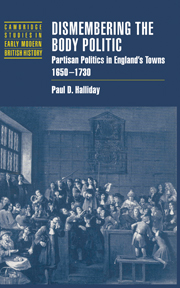Book contents
- Frontmatter
- Contents
- Preface
- List of abbreviations
- Part one Corporate ideal and partisan reality
- 1 The paradox of partisan politics
- 2 “The best of polities”
- 3 From purge to purge: Civil War, Interregnum, and Restoration in the corporations
- 4 Partisan politics, 1663–1682
- Part two The King and his corporations, 1660–1688
- Part three Partisan conflict and the law in a dynamic society
- Appendix A Royal charters of incorporation, 1660–1727
- Appendix B Enforcement of the Corporation Act, 1662–1663
- Select bibliography
- Index
- Titles in the series
3 - From purge to purge: Civil War, Interregnum, and Restoration in the corporations
Published online by Cambridge University Press: 10 November 2009
- Frontmatter
- Contents
- Preface
- List of abbreviations
- Part one Corporate ideal and partisan reality
- 1 The paradox of partisan politics
- 2 “The best of polities”
- 3 From purge to purge: Civil War, Interregnum, and Restoration in the corporations
- 4 Partisan politics, 1663–1682
- Part two The King and his corporations, 1660–1688
- Part three Partisan conflict and the law in a dynamic society
- Appendix A Royal charters of incorporation, 1660–1727
- Appendix B Enforcement of the Corporation Act, 1662–1663
- Select bibliography
- Index
- Titles in the series
Summary
Music, speeches, a bonfire for the inhabitants, and a large dinner for the corporation: the bailiffs, magistrates, peers, and headboroughs of Kingston upon Thames begrudged no expense celebrating the King's restoration in May of 1660. Three pounds went to the trumpeters alone. Another pound paid the ringers at the bell tower.
The joyful peals of 1660 must have grated on the ears of those who had created the political discord of the last decade. Kingston's corporation had begun to fall apart in 1653 with the removal of one headborough and the refusal to swear another into office. By the following year, well-defined factions, hardened in their opposition to one another, struggled for control. In August 1654, members unsympathetic to the Protectorate tried but failed to dismiss bailiffs Theophilus Colcock and Obadiah Wicks. Colcock and Wicks countered two days later, dismissing from the corporation six of those who had just voted for their ouster. Then Colcock, Wicks, and their partisans elected three new men “to make strong Colcock's faction.” By purging their foes, Colcock and Wicks could now feel confident in their hold on authority.
But even in the mid-1650s, officers wrongly removed had some recourse in the courts. Those dismissed turned to the Upper Bench – once the court of King's Bench – where they sued for writs of mandamus. The court complied, directing that the corporation “restore, or cause to be restored [those removed], or do signify to us the cause thereof to the contrary.”
- Type
- Chapter
- Information
- Dismembering the Body PoliticPartisan Politics in England's Towns, 1650–1730, pp. 56 - 105Publisher: Cambridge University PressPrint publication year: 1998

